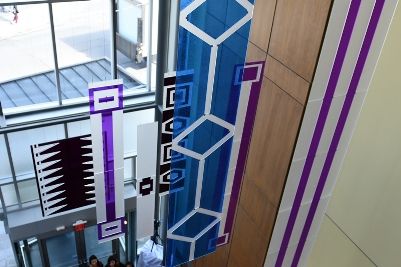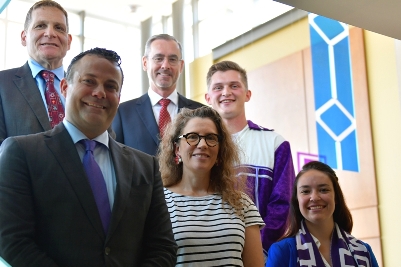
Queen's Law has unveiled a permanent art installation in its lobby, paying tribute to Indigenous Peoples.
Every time students, faculty, staff, and visitors enter the Faculty of Law building, they will be met with a reminder of the original inhabitants of the land on which Queen’s sits.
This spring, the Faculty launched a competition to commission a piece of Indigenous art to reside in the building's atrium. The goal of this installation was to portray the relationship between Indigenous Peoples in Canada and the law.
“I know that the entire Queen’s Law community is thrilled with this beautiful addition to the school’s atrium, a moving recognition that Queen’s University is situated on the traditional territory of the Anishinaabe and Haudenosaunee peoples, as well as an important tribute to Indigenous legal systems,” said Dean Bill Flanagan.
His acknowledgment of traditional territory came after a Thanksgiving Address (Ohenton Karihwatekwen, the Words Before All Others) by first-year Law student Brandon Maracle, and was followed by an address from Queen's Principal Daniel Woolf, a reflection from second-year Law student Shelby Percival, and David Sharpe, Law'95 with an introduction to a talk by the artist, Hannah Claus.

Artist Hannah Claus’ proposal, “words that are lasting,” was announced as the winner in May, and she spent the summer preparing the art piece, which includes recreations of seven wampum belts suspended from the lobby ceiling.
“I had to make sure that I had the permissions to recreate these historic Wampum belts, so there was some time spent getting in touch with different groups,” she says. “The belts are modeled after different agreements within the Haudenosaunee Confederacy and between the Haudenosaunee and the Anishinaabe – the two main Indigenous groups who inhabit this area.”
Claus is a visual artist of English and Kanien'kehÁ:ka / Mohawk ancestries and a member of the Tyendinaga Mohawks of the Bay of Quinte. She teaches contemporary Indigenous art as a sessional lecturer at Kiuna, a First Nations post-secondary institution, in Odanak, Québec.
She is hopeful the art will both give Indigenous students, faculty, staff and visitors something that relates to them when they enter the building, and encourage non-Indigenous people to learn more about the populations and cultures who live where they have chosen to study.

“The belts create an Indigenous presence as soon as you come into the space,” she said, noting that wampum belts are a tradition of Indigenous groups inhabiting the eastern part of the continent. “As they were being installed, a professor from an Indigenous Law course walked by and was very excited – he says he intends to bring his class down to the lobby at the start of term going forward.”
The installation of this public art piece is an important element of the Faculty of Law’s multifaceted response to the Calls to Action of Canada’s Truth and Reconciliation Commission.
Watch the ceremony on the Queen's streaming server.
By Phillip Gaudreau